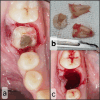A novel technique for computer-assisted dental autotransplantation: A case report with 42 months of follow-up
- PMID: 40673116
- PMCID: PMC12261065
- DOI: 10.34172/japid.025.3760
A novel technique for computer-assisted dental autotransplantation: A case report with 42 months of follow-up
Abstract
Dental autotransplantation (DAT) is an effective technique for replacing missing teeth. This case report presents a novel computer-assisted approach using cone-beam computed tomography (CBCT) for 3D planning. A 15-year-old female with a hopeless molar due to failed endodontic treatment underwent DAT. Following 3D planning, the donor tooth was surgically extracted and transplanted into the prepared socket, followed by semi-rigid splinting. A meticulous 42-month clinical and radiographic follow-up demonstrated the success and stability of the procedure. This innovative method emphasizes the role of advanced computer technology and 3D imaging in enhancing surgical precision and treatment outcomes. Within the limitations of this case report, DAT, combined with computer-assisted planning, proved a reliable and predictable treatment option for replacing hopeless teeth, particularly in young patients. This approach showed the potential of DAT to transform tooth replacement strategies with better accuracy and decision-making.
Keywords: Autologous transplantation; Case report; Dental implant; Third molar.
© 2025 The Author(s).
Conflict of interest statement
The authors did not disclose any conflicts of interest.
Figures
References
Publication types
LinkOut - more resources
Full Text Sources







